When people ask me, “When is the best time to travel to Costa Rica?”, my honest answer is: it depends on what you’re looking for. Having been born and raised here, and after nearly three decades working as a certified guide and tour operator, I’ve seen every corner of the country in every season.
We only have two seasons: the rainy season and the dry season. And of course, this also depends on where you are. In some areas like the rainforests, we joke that we have the rainy season and the “wetter” season”, because it can feel like it rains all year round. But hey, that’s why those forests look so magical.
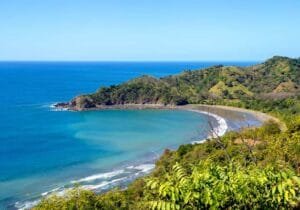
Understanding Costa Rica’s Seasons
Costa Rica’s climate is all about the dry season (December–April) and the green season (May–November), but here’s something many travelers don’t realize: our temperature isn’t determined by the time of year, but by altitude.
The lower you go, the warmer it gets (hello, steamy beaches and lowland jungles 🌴).
The higher you climb, the cooler and fresher it feels (perfect for cloud forests like Monteverde).
That’s why in one trip you can go from sweating in flip-flops at sea level to pulling on a sweater in the highlands—all in the same day.
Dry Season (December to April)
The dry season is our most popular time for travelers—and for good reason. From December through April, the weather is hot, sunny, and reliable almost every day. It’s the perfect choice if you want long beach days, volcano hikes under clear skies, or guaranteed sunshine for your trip.
That said, this is also the busiest season. The Costa Rica Tourism Board (ICT) highlights this period as one of the busiest times of the year for tourism, with higher occupancy in the most popular areas. From my own years guiding during this time, I’ve often recommended early-morning excursions—it’s the best way to enjoy places like Monteverde or the Pacific beaches before the crowds arrive (and before the sun gets too intense; trust me, tropical sun is not shy).
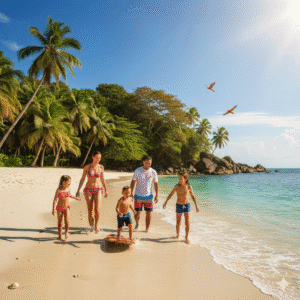
Green Season (May to November)
Personally, I have a soft spot for the green season. Mornings are usually bright and sunny, but by afternoon, refreshing rains roll in, cooling everything down. This is when forests and waterfalls look their most vibrant—a paradise for nature lovers and photographers.
It’s also when you’ll find fewer tourists and more favorable prices. In fact, some of my favorite guiding experiences have been during these months, walking with travelers through lush trails where the only sounds are birds, monkeys, and the rain falling softly on the canopy. (Just don’t forget a good rain jacket—you’ll thank me later.)

Best Time to travel to Costa Rica by Traveler Type
Not every traveler is looking for the same thing. Over the years, guiding people from all over the world, I’ve noticed that the “best time” really depends on who you are and what you want out of your trip.
For Nature and Wildlife Lovers
The green season is a dream. Wildlife tends to be more active, rivers are flowing, and forests are alive. Some of my most memorable moments have happened in the rain—like spotting quetzals in Monteverde wrapped in mist.
For Beach and Sun Seekers
If your idea of Costa Rica is endless sunshine, piña coladas, and golden sunsets, then the dry season is your paradise. Just bring sunscreen—lots of it. 🧴☀️
For Adventure Travelers
Hiking volcanoes, rafting wild rivers, ziplining over forests—Costa Rica is an adventure playground all year round. Shoulder months like May–June and September–October give you the best of both worlds: fewer crowds, good prices, and plenty of action.
For Budget-Friendly Trips
The green season is your ally. Hotels and tours often drop 20–40%. I’ve seen travelers upgrade from hostels to eco-lodges just because of rainy-season discounts.
For Family Vacations
For U.S. families, summer break (June–August) overlaps with our green season. Mornings are sunny, afternoons bring some rain, and kids usually love the adventure. Costa Rican families also vacation in the first two weeks of July (our mid-year school break), so popular spots can feel lively with both locals and international visitors.
Best Time to travel to Costa Rica by Region
Costa Rica may be small, but its microclimates mean the “best time” changes depending on where you go.
Pacific Coast
The Pacific is the most visited region.
Dry Season: Sunny, beach-perfect, classic postcard weather.
Green Season: Lush, waterfalls in full force, dramatic sunsets.
North Pacific (Guanacaste)
Here the dry season transforms the land. Trees drop their leaves (deciduous forests), turning green hills golden brown. It’s beautiful but very different from the rainforest image many travelers expect.
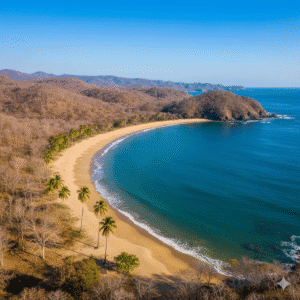
Central & South Pacific
These areas remain evergreen year-round thanks to heavier rainfall. Think dense jungles rolling right down to the beach—places like Uvita, Dominical, and Corcovado.
Caribbean Coast
The Caribbean dances to its own rhythm, with its best weather in September and October. It’s also wilder, home to Afro-Caribbean culture, music, food, and spectacular wildlife. One of the most emotional moments I’ve ever witnessed in nature was watching baby sea turtles hatch and scramble toward the ocean under the stars in Tortuguero. And just a friendly heads-up: while Sept–Oct is a fantastic time to visit, it’s still a rainforest—so showers can (and do) happen. In fact, those nighttime rains are simply the water cycle doing its job to keep the forest alive and glowing.
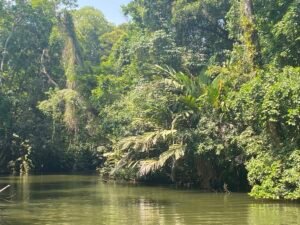
Cloud Forests and Volcanoes
Altitude makes these regions cool year-round. Monteverde’s misty trails and Poás or Arenal volcano hikes are great in both seasons. One of my favorite guiding moments: waiting hours for Arenal’s cone to clear, only to have the clouds part suddenly—the whole group cheered like we’d just seen a rock star.
Month-by-Month Guide: Best Time to Travel to Costa Rica
Costa Rica may only have two official seasons, but if you spend a little time here, you’ll notice that there is not a really best time to travel to Costa Rica because each month has its own rhythm. Here’s a breakdown:
January – February: Dry, sunny, popular, great for beaches.
March – April: Hot, busy with Semana Santa and U.S. spring break crowds. Energetic but crowded.
May: Start of the green season. Forests explode with life, birdwatching peaks with resident species becoming more active.
June: Rincón de la Vieja comes alive—forests green up, waterfalls roar, fumaroles steam dramatically.
July: El veranillo de San Juan brings a short “summer” in the rainy season. Families (both local and U.S.) love this month.
August: Southern Caribbean shines—Puerto Viejo, Punta Uva, Cahuita. Calmer seas, sunnier days, Afro-Caribbean culture.
September – October: Pacific rains hardest, but the Caribbean stays sunny thanks to shifting winds. Best time for coral reefs, jaguar sightings, and fewer crowds.
November: Transition month—green beauty meets dry skies. Coffee harvest begins; mills in Tarrazú, Naranjo, and Poás run at full capacity. Poás Volcano, if open, shows off its massive crater.
December: Dry season begins. The entire country is buzzing, especially Nicoya Peninsula, Manuel Antonio, Arenal, and Monteverde. Festive season, high prices, but incredible energy.
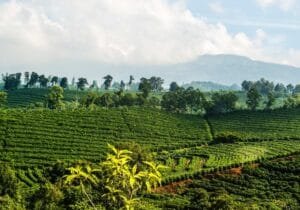
Costs, Crowds, and Festivals
Travel here isn’t just about weather—it’s about how busy the trails are and how much you’ll pay for your room..
High Season (December – April)
Great weather, higher prices, bigger crowds. Book early!
Low Season (May – November)
Better deals, fewer tourists, more space (sometimes it feels like you rented the whole forest).
Festivals and Busy Periods:
January (school holidays): Very crowded, as many Costa Rican families from the Central Valley travel before the new school year starts.
Semana Santa (March/April): Packed beaches, strong traditions.
First two weeks of July: Local families vacation; destinations fill with Ticos.
Independence Day (September 15): Parades, folkloric dances, lanterns.
Christmas & New Year: Fireworks, tamales, pura vida energy everywhere.
And don’t miss a fiesta patronal if you stumble across one—bull riding, music, food, and maybe some questionable karaoke.
Frequently Asked Questions
What is the cheapest month to travel to Costa Rica?
September and October are usually the cheapest months, especially on the Pacific side. On the Caribbean, you’ll also find sunny days and good deals.
Is September a bad month to visit Costa Rica?
Not necessarily. The Pacific can be very rainy, but the Caribbean is usually sunny and calm—it’s one of the best times to enjoy Puerto Viejo or Cahuita.
Which month has the best weather in Costa Rica?
January to April are the driest months, offering plenty of sunshine. If you like lush scenery, May to July are excellent for the green season.
Can I see wildlife during the rainy season?
Yes! In fact, wildlife is often more active—frogs, birds, monkeys, and many other species take advantage of the lush conditions.
Which is better, the Pacific or the Caribbean coast?
It’s hard to choose—both coasts have their own charms. The Pacific offers more infrastructure, a wide range of activities, and incredible national parks where you can explore beaches, volcanoes, and jungles. The Caribbean, on the other hand, brings Afro-Caribbean culture, lively towns, great snorkeling, and its sunniest spell in September–October. In the end, both sides are rich in wildlife and natural beauty—the best choice depends on your personal travel style and the kind of experience you want.
Is Costa Rica crowded in January?
Yes. It’s a busy month because of international visitors and Costa Rican families vacationing before the school year begins.
What is the best month for birdwatching in Costa Rica?
May is excellent because the rainy season starts and resident birds become more active, but birdwatching is rewarding year-round.
When is the coffee harvest season?
It begins around November and runs through the early months of the following year. Visiting regions like Tarrazú, Naranjo, or Poás then lets you see mills working at full capacity.
Is Easter (Semana Santa) a good time to travel?
It’s a colorful time with processions and traditions, but beaches and tourist areas get very crowded, and prices go up.
Do I need to worry about hurricanes in Costa Rica?
No. Costa Rica is outside the main hurricane belt. You may see heavy rains, but direct hits from hurricanes are extremely rare.
Final Thoughts: Choosing Your Best Time to Travel to Costa Rica
At the end of the day, there isn’t a single “perfect” time to visit Costa Rica—it really depends on your interests, your travel style, and what you want to experience.
Whether it’s chasing waterfalls in the rainy season, enjoying endless sunshine at the beach during the dry season, or exploring local festivals with Costa Rican families, each time of year has its own magic.
After guiding travelers for almost three decades, my advice is simple: come with an open mind and a bit of flexibility. Costa Rica will surprise you in the best ways—whether it’s the weather, the wildlife, or the pura vida lifestyle that makes you slow down and enjoy the moment.
So, don’t overthink it too much. Pick the time that feels right for you, pack your bags, and let Costa Rica do the rest. 🌿✨

Still can’t decide between dry and green season?
So you still don’t know when is the best time to travel to Costa Rica. No worries—Costa Rica will look amazing either way (it’s like choosing between chocolate cake and cheesecake). If you’d like me to help you plan the details, drop me a message. I’ll make sure you get the best of whichever season you pick.



